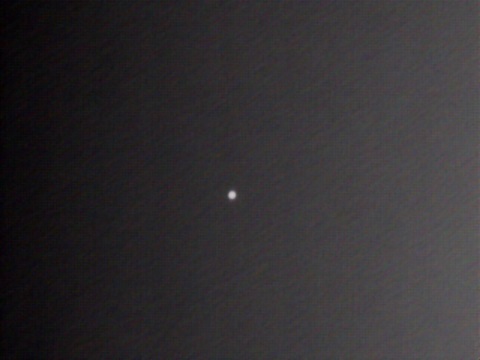Our customer Jörg Schoppmeyer sent us this unusual picture: a circular Mercury, shortly after the upper conjunction and only 1.8° away from the Sun!
18.08.2020: Mercury near the upper conjunction with the Travel-Companion 95/580, © Jörg Schoppmeyer
Mercury is traditionally a difficult object to observe. The reason: The small planet is always close to the Sun and can be seen with the naked eye only shortly after sunset or before sunrise when it is at maximum distance from the Sun. Legend has it that even the great astronomer Johannes Kepler never saw Mercury with his own eye - but Kepler did not have a modern telescope with accessories from Baader Planetarium...
During the hunt for Mercury, the Sun is at the edge of the field of view - but there is no danger for the tube with the 2" Herschel wedge.
Perfectly equipped for hunting for the planet so close to the Sun
Would it really be possible to catch the tiny Mercury with a brightness of only -1.8mag next to the much brighter Sun? This requires maximum contrast without stray light - neither from inside the telescope nor from outside. Shadow for the observer was provided by a shading plate placed on the tube, while the Herschel wedge provided maximum image contrast. The ceramic plate of the heat trap also always reliably indicates the position of the Sun - to make sure that it doesn't come too close to the tube and might scorch the inside of the telescope! With a 1.25" Herschel Wedge, this experiment would not have been possible.
With the usual gray filter for additional light attenuation, Mercury could not be seen. The breakthrough came with the contrast booster, with it it was much easier to find the small planetary disk in the image and then capture it photographically.
We can only congratulate on this rare shot - when do you ever see Mercury not as a crescent at a "comfortable" distance from the Sun, but as a "full Mercury" behind the Sun?
ATTENTON
Working in such close proximity to the sun without a sun filter carries the risk of accidentally getting sunlight into the telescope, which leads to immediate blindness when used visually! We therefore advise you against imitation.
Every Solar Diagonal needs additional neutral density filters since the reflected energy of the first surface prism (4.6%) still is a factor of 1000 too large for the human eye. All Baader Solar Diagonals are delivered with a pre-mounted ND 3.0 Baader precision 2 light reduction filter. The photographic version includes other ND-Filters to achieve shorter exposure times. Use with care!
About the author: Alexander Kerste

Alex is a studied biologist and works as a freelancer as an author, consultant and translator. After his studies and the publication of the Kosmos Starchart-Set in 2004, he was a regular freelancer for Astronomie Heute and the yearbook Der Himmel for the Spektrum-Verlag in Heidelberg. He is in charge of the Beginner courses on www.Astronomie.de and is a voluntary active member in the Robert-Mayer-Observatory since 1993. Since then, he has published a number of books on Celestron-Telescopes as well as Digiscoping and Astrophotography. One of his books on Astronomy with binoculars is also freely available at freebook.fernglasastronomie.de. In addition he supervises the Northern lights and star tours from Hurtigrute – these were also published in a travel guide, further articles can also be found on his blog kerste.de.












Hello
I thought you could observe the sun with this prism and it’s filter alone. Could you explain about scorching the telescope ? Is this when sun light enters tube off axis and would touch inner walls ?
The ceramic plate of the heat trap also always reliably indicates the position of the Sun - to make sure that it doesn't come too close to the tube and might scorch the inside of the telescope!
Cheers and Happy New year
Yes, exactly that's the problem: There is no risk if the telescope is pointed directly at the Sun, so that the beam of light passes straight through the telescope and to the Herschel prism.
But if you point it at an object close to the Sun, then there is the risk that the beam of light of the Sun does not completely pass through the Herschel, but hits the inside of the telescope. Even if the telescope is made of metal, then the dark paint inside of the tube or the grease of the focuser may get hot and evaporate, which may result in some smear on the lenses when it condenses again.
That's also the reason why we don't offer 1.25" Herschel prisms: The risk is too high that the beam of light will hit the sides of the telescopes if the tracking isn't accurate, and with a 1.25" prism, you have a much smaller margin of error than with a 2" prism.
Hello, with regard to your answer above, do you mean that the margin of error is much smaller with a 2" prism, since you mention that you do not offer the 1.25" Herschel prisms? In other words: "...and with a 2" prism, you have a much smaller margin of error than with a 1.25" prism."? Or am I misunderstanding this? Regards, Nello
This is maybe a misunderstanding. The meaning of the text is, that with a 2" Herschel wedge its easier to bring the Sun and Venus in the right position because it has a larger field of view.